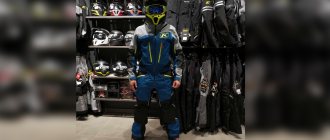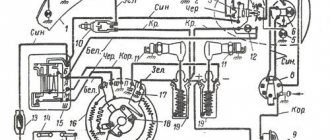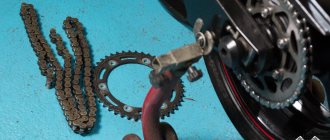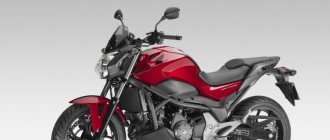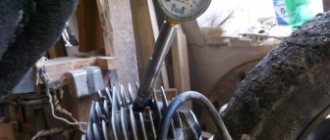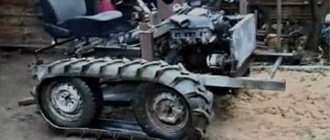Among the equipment for sports riding, there are well-established protective elements and materials, such as leather, motorcycle overalls or an integral helmet. Why them? The main function of equipment for sportbike owners is designed to protect against slipping, in other words, it is abrasion resistant.
"The game of balance is a slippery slope"
“Why specifically for abrasion,” you ask.
It's about the nature of the ride and the method of maneuvering. In articles on injuries, we looked at what kind of damage a person receives depending on certain accidents.
“Motorcyclist injuries are no joke. First part"
“Motorcyclist injuries are a dangerous situation. Second part"
Sports motorcycles are more prone to tilt than other classes. Increased speed in combination with asphalt and lean angles sooner or later results in loss of control and enchanting sparks on the surface, burned out by the sliders and plastic of the bike. “Impact” accidents occur among amateurs and professionals, but the majority, according to statistics, become familiar with a slipper during almost any fall.
“What else do you need to know about motorcycle injuries?”
“What to do if you fall off a motorcycle?”
So what equipment should a sportbike owner look for?
All equipment for sports motorcycles, in addition to increased abrasion resistance, should contribute to the best aerodynamics. Such protection should not have any protruding parts that could strongly resist the wind, thereby interfering with the motorcyclist.
Motorcycle overalls
“Why are overalls so popular?”
“Icon Hypersport Suit motorcycle overalls - why are they so good?”
The motorcycle overalls are suitable for motorcyclists who claim to be “pro”, as they are not very comfortable for everyday riding. A person choosing overalls does this for two reasons: he knows exactly what he needs and why, secondly, he has not yet experienced the intricacies of driving around the city in overalls and having to change clothes when arriving at work.
If we are talking about the track and professionalism, then undoubtedly the overalls are a good choice, because it completely protects the pilot’s body. The biggest criticism thrown against separates is the danger of the jacket riding up and exposing your back during an accident. Such flaws do not happen with one-piece overalls.
Engine covers
As for engine covers, we won’t talk much about them, because their essence is simple, and the price is indecently high. It’s easy to select protective covers according to the make of the motorcycle, with tears in your eyes you’ll have to pay a huge amount for them, but be sure that if you fall, your horse’s heart will remain intact. However, these covers will not protect either your beautiful plastic or protruding parts like mirrors or steering wheel handles. Therefore, this moment of tuning is for the rare buyer who saves on the weight of the motorcycle, takes care of the engine and cries at night remembering how much this pleasure cost him.
Motorcycle pants
Also fitted models made of leather or materials close to it, with additional inserts on the knees and hips.
The trousers include elastic elements for a comfortable ride in a sporty fit. Along the edge of the legs, the cut is tapered for comfort when paired with high motorcycle boots. The zippers are sewn in such a way as not to cause any discomfort to the pilot, and elastic straps allow you to bend down to the bike in a sporty position.
- 5
New YearIcon Hypersport 2 motorcycle pants
To order (30 days)
RUB 30,700 –15% Price 26,095 rub.
–15%
Sliders
An elementary design, which in words can be represented as a knob with fastening. Sliders are attached to the frame, to the wheel axle or even to the steering wheel handle. A good option for fans of motorcycles with a lot of plastic, because the sliders have virtually no impact on the appearance. On sportbikes, this method of protection does not change the balance and does not make the design of the motorcycle heavier, and as you know, in the fight for speed, every gram is important.
Sliders are usually disposable protection because most of them wear out when sliding. Due to the fact that there is only one attachment point or at most (but rarely) two, and the size of the slider is not large, there is simply nowhere to dissipate the impact energy from the fall. Sometimes, after a fall, a motorcycle in a slipper can get caught by the slider on an uneven road, get into a groove and get caught, then you risk getting an additional bonus in the form of a twisted frame.
Conclusion: sliders are a good choice for sports model motorcycles, they do not affect weight or aerodynamics, but protect in case of a fall, only mainly for one time and exclusively the motorcycle itself. In addition, due to its modest size, protection can be considered local, partial.
Arcs and cells
I consider bars and cages to be the most effective means of protecting a motorcycle. For a second, the bars, depending on the design, save not only the motorcycle, but also the driver’s legs. Protective covers or sliders will not allow the rider to remove his feet from under a fallen motorcycle.
Of course, most of the arches are quite bulky, which is why they are not favored by supporters of high-speed models and motorcycles with a lot of plastic. Arcs are the choice of road workers or choppers. Moreover, there is room for installing additional options, such as running boards, for example. Who doesn’t want to stretch out their numb legs on a long journey?
Cells are more universal in their purpose. The fact is that the arches load the front part of the motorcycle and sometimes look awkward. Cages are gaining popularity among urban motorcycles as a means of additional protection and as a way to tune your favorite machine. The cage can be installed on different classes of motorcycles, except that they will look ridiculous on choppers. The bright color of the cage gives it an original look; some even manage to combine them with plastic.
Due to their design, both the arcs and the cells distribute the impact energy over their entire area and, of course, this is reusable protection. Recently, it has become important to supplement cells with sliders. An interesting solution, because the cage itself is quite expensive, and repainting it after a fall will not be easy, but replacing the slider on it is welcome.
Such protective equipment is not difficult to purchase, and you can install it yourself. It is logical that both the choice of equipment for the class of motorcycle and the choice of protection for the motorcycle itself should be correlated with your travel plans. Sliders will be completely out of place on heavy choppers or road bikes; at most, place them on the steering wheel or wheel axle, but the cages on them will be just as funny. Just imagine some V-Twin, say my pink dream - Boulevard, chained in a cage? Laughter and nothing more, Michio Suzuki (founder) would throw a wrench at someone who would do that. It would be no less funny to install roll bars on a sportbike. Firstly, you still need to try, and secondly, it will have a catastrophic effect on the balance and controllability of the motorcycle.
Therefore, when choosing protection for your motorcycle, focus not only on the price, but also on the ease of installation/disassembly, how the new product will fit into the system of your motorcycle and how much it will affect handling.
How motorcyclists can improve their chances of survival
Prepare a sleigh in the summer and a cart in the winter. It's the same story with equipment. Those who decide to ride a two-wheeled vehicle next season can start thinking about motorcycle protection now. It is not cheap, but it is not recommended to travel without it, especially for beginners. We visited a specialized store to find out as many nuances as possible when choosing motorcycle equipment. In addition, we will select motorcycle protection for the traveler, “athlete”, city slicker, and also calculate how much the minimum set for the first trip will cost.
When choosing equipment, beginners often make mistakes, after which various Internet sites (like our “Motobazaar”) are replenished with advertisements for the sale of certain slightly used or even new protection elements. A person buys a helmet without knowing the nuances, then realizes that he bought the wrong thing - and is forced to sell it, usually at a lower price. Therefore, the choice of equipment must be approached with the same care as the choice of a motorcycle.
Another big mistake is riding without equipment, only with a helmet. Here, for example, is a video in which a guy falls off a motorcycle without any equipment. The speed is very low. The motorcyclist was able to get up, pick up the bike and return home. Still got off well! But the whole body is covered in blood and burns, there is no skin in places - it will take a long time to heal. What if the speed was higher? Meat, excuse me, would wear it down to the bone.
Equipment, of course, is not a panacea for all ills, but it significantly increases the chances of survival and protection from serious injuries. Even after a small fall, you can leave the scene of an accident in an ambulance completely covered in blood and green paint, or you can simply shake off the dust from your equipment, pick up the motorcycle, and move on.
When choosing motorcycle protection, first of all, you need to consider what type of bike you will have and how you are going to use it. For example, a leather overall and integral will look very strange at enduro. And not only does it look weird, but you won’t be able to drive off-road in the summer in leather for a long time. Motorcycle protection must be selected for specific operating conditions.
Helmet everyone's head
It is recommended to buy the most expensive helmet you can afford. There is definitely no need to skimp on this piece of equipment. And here it’s not only about safety, but also about comfort. Cheap helmets from the Middle Kingdom (precisely cheap!), in addition to being dangerous to ride in, are also noisy, heavy, and the wind blows through them. Lack of comfort will eventually force you to buy a more expensive, high-quality and equipped helmet.
On the other hand, you need to weigh your capabilities. It’s better to buy inexpensive motorcycle equipment, but all of it, than to ride in a helmet for 2,000 Belarusian rubles without other protective elements. For example, decent helmets can be bought for around 400 rubles, and these will be certified and tested models.
It is very important to choose the right helmet size. Because if you make a mistake, serious security problems can arise. In the last two motorcycle accidents that occurred in Belarus, the helmets of three people fell off (!), two of them died, the third was in serious condition. Therefore, a helmet that is not properly fitted for a motorcyclist or passenger or is poorly fastened is of no use. The helmet strap should be fastened under the chin as tightly as possible without causing pain or severe discomfort. The clasps should not dangle on the strap, but should be pulled tightly under the chin.
Trying on a helmet is mandatory! Do not buy such items online without first trying on this particular model in a store. Different manufacturers have their own markings: for example, a Shark size M may not match the emka of an LS2. Moreover, it is not a fact that size M of different models from the same manufacturer will suit you.
In principle, this rule applies to all elements of equipment - they must be selected strictly in size, otherwise they will not effectively protect the body. An entire article could be written on how to choose a helmet. It is better to carefully study this issue on the Internet. For example, here. The right helmet, as recent tragic news suggests, can save lives.
Which type should I choose? Let's start with a fully closed helmet - an integral. Its advantages are the highest degree of head protection, good noise insulation, low aerodynamic drag, and better protection of the motorcyclist from wind, rain, dust and insects. But such helmets quickly become hot when driving at low speeds in the city. Therefore, special attention should be paid to the presence of high-quality ventilation. In addition, pay attention to the viewing angle - in a helmet with a wide visor it will be more convenient to monitor the “dead” zones when changing lanes.
In many integral models it is difficult to ride with glasses. But some have special channels for them.
Visors are available in clear, tinted and mirrored versions. It makes sense to take tinted ones if you mainly drive in hot weather on a sunny day. They will be very uncomfortable at night.
It is optimal to take ordinary transparent ones, but choose models with sunglasses that will prevent you from going blind from the bright sun. It is important here that the glasses are large and go as low as possible. Sometimes there are narrow glasses in helmets - they are of little use, since they do not completely cover the eyes.
It is also recommended to purchase a pinlock for the helmet if it is not included in the kit. Pinlock is a special lens that prevents the visor from fogging in cold or rainy weather. In addition, some helmets have cheek pads. But it is not necessary if the helmet fits well.
You shouldn’t buy a purely black helmet; today there are a lot of interesting models in design and coloring. You need to be as noticeable as possible, including through bright equipment. By the way, it wouldn’t hurt to buy a reflective vest. The desire to become as noticeable as possible will arise after your first meeting with an inattentive driver. And you will meet him very quickly.
There's nothing wrong with reflective vests and colorful helmets. You can be stylish in them too. Although for some reason many people only drive in black. I also chose all black, which I now regret. Fortunately, you can buy a vest.
For those who want to become more visible, there are helmets with a special reflective coating. Recently, backlit models have appeared.
Girls can be advised to buy “girlish” helmets. Or attach a ponytail at the back. In general, it is advisable to indicate your gender identity. This way there is less chance of running into an aggressive driver - the attitude towards motorcyclists on the road is completely different.
And men will have to face an inappropriate attitude on the part of some car enthusiasts. Such encounters, when you are deliberately (precisely on purpose) “cut off” or forced out of the lane, are very rare, but it is better to immediately buy a camera for your helmet.
Speaking of white helmets. They are not as hot as black ones, but you will have to wash them more often. This rule generally applies to all equipment - light-colored elements are more comfortable in hot weather, but are more easily soiled.
Modulars are helmets with a rising face. You can drink, eat, smoke or just talk in them without taking off. That is, they are very convenient for long journeys. In addition, the modular eliminates the need for a motorcyclist who wears glasses to take them off and put them on every time he takes off and puts on his helmet. As a bespectacled person, I can say that this procedure is really, really annoying. My next helmet is definitely a modular one.
There are models that allow you to remove the “jaw” all the way to the back of your head, but still leave the visor in its place. In such helmets you can ride comfortably in both modes, either by fastening the jaw part or by sliding it back. But such models usually cost a lot.
The disadvantages of modulars are that the sound insulation is worse and the weight is greater. Integrals are also safer. Although in any case, in terms of protection, helmets with a rising face part are much better than open ones.
Next come open helmets, which are usually chosen by chopper and scooter riders. They are very comfortable in the city in warm weather, but outside the city (if the motorcycle does not have good wind protection) it blows quite a lot at speed. The main problem with these helmets is that when you fall, your face, especially your jaw, suffers greatly.
But to be stylish, many take risks. There are also helmets that protect only the upper part of the head (the so-called “watermelon rind”), but none were found in the Motoplanet store, which acted as a technical consultant. These “helmets” are really of no use.
If you like to go off-road, then you need an enduro or motocross helmet. The visor will protect from dirt, sun and branches. The lower elongated “jaw” protects against “facial” falls and also allows you to fix glasses. A high degree of protection and good ventilation - it's all there. But in terms of aerodynamics they are inferior to integrals and modulars.
Such helmets with visors are often purchased by owners of touring enduro bikes for long trips. But for “civilian” use it is important that the visor can be unscrewed - on the highway the wind can unpleasantly lift your head up. And for hard off-road driving you need to use a motocross helmet with goggles and special equipment. But we will not touch on this topic - there are too many nuances in it. The guys from the “In the Helmet” channel will talk well about off-road equipment.
The Shark line of models includes hybrid helmets that combine the advantages of integral and cross helmets. Some of them have a removable lower part, which allows them to be used as open ones. But if at a traffic light in hot weather you want to lift the front of your helmet or remove your glasses, you won’t be able to do this with two fingers. You'll have to use both hands. Hybrids have better ventilation than integrals, but they can hardly boast of good sound insulation at high speed.
Although its main feature is still a stylish appearance.
Leather or textiles?
For the race track, leather gear is definitely a must. But for “civilian” use, it makes sense to opt for modern high-quality textiles. It also protects well from falls, but is more comfortable and practical. Motorcycle travelers choose only textile clothing.
Leather is stronger and more durable than textiles. After falls, there is a chance that the equipment can be used again. When sliding on asphalt, the skin will be rubbed longer, therefore the likelihood that the pilot will be injured when falling at speed is much lower. Leather stretches well, so it can be adjusted to size without altering the item, but simply by breaking it in.
But it has enough disadvantages. The skin is hot on hot summer days. It fits the body very tightly and creates discomfort when you get off the motorcycle. The equipment quickly wears out and fits along the curves of the body, but at first you will have to endure inconvenience. It also begins to sag over time. It is difficult to initially select the right size: the protection must immediately sit in place and not dangle. At the same time, a leather jacket has a minimum of adjustments. Leather is heavier than textiles and can withstand rain unpredictably. If it is of high quality, then nothing bad will happen to it, although it will take a long time to dry. If the skin is bad, it may shrink and become stiff when dried. In addition, such equipment costs more on average.
There is also perforated leather. I have just such a jacket with small perforated inserts in the chest area. It's still a bit hot in traffic jams in the summer. But if you move, the oncoming wind pleasantly cools the pilot through the perforations. However, the problem is that in cool weather it is cold to ride a motorcycle without a windshield, even with the insulated pad attached.
Textile equipment can be very different, so we will talk about more or less high-quality items. In terms of strength and wear resistance, textiles are inferior to leather. Typically, textile equipment is considered disposable, but this is not entirely true. If you drive at a reasonable speed, then quality (and I mean quality) textile gear should survive a fall. At high speeds it will provide protection, but after that it is almost guaranteed to have to be replaced due to through holes. That is, it will fulfill its protective function, but after an accident it will have to be thrown away. Here is an example of what will happen to textile equipment after a fall at speeds over 110 km/h. The “equipment” was scrapped, but the pilot and passenger remained unharmed and were not even seriously injured, although they slid for a very long time.
Textiles are significantly lighter than leather, making such equipment much more comfortable. There are almost always adjustments that can be used to adjust the position of the protection and secure it. By the way, for textile equipment the rule remains that it should fit as tightly as possible.
A rag jacket often has all sorts of linings that make it as versatile as possible. They can insulate the pilot and protect him from rain. The linings can be sewn or detachable, and separately from each other. In combination with the ventilation system, you get a very good transformer, in which you can drive in the heat, rain, and cold.
The cost of textile equipment varies greatly. There are cheap mesh jackets for hot weather, as well as high-quality touring jackets that can be worn in the desert or high in the mountains. Moreover, these jackets are often worth the money. And it’s better not to save on this, because if you buy something cheap, you’ll later have to buy more equipment for colder or, conversely, warmer weather. And this often ends up being more expensive. With our temperature changes, it is better to take something more universal.
Or take the “turtle”?
Standard protection built into rider clothing provides only a basic level of safety. To ensure that the jacket can protect against more severe damage, some purchase additional protection, such as “turtle” protection. In addition, it is used separately during the hot season, since it is well ventilated.
But the “turtle” will provide maximum protection only if you wear it under a motorcycle jacket. Since the protection elements can turn, it is recommended to use it only additionally.
For example, Ekaterina Arkhipovich, a motorcycle traveler, removed all the built-in protection from an ordinary motorcycle jacket and instead puts on an expensive and high-quality “turtle” under the jacket. He says it's safer this way.
Some protection elements can be purchased separately. Often they order more powerful back protection for a jacket instead of a standard insert.
Legs suffer the most...
In an accident, the motorcyclist's legs suffer the most, so it is important to protect them as much as possible with the help of motorcycle pants, knee pads and motorcycle boots.
First of all, you need to protect your legs from abrasions - special motorcycle pants made of durable leather or fabric reinforced with Kevlar will help here. Built-in protection helps protect your knees and hips. You can buy regular motorcycle pants and add powerful articulated knee pads to them.
But the motorcyclist still has an Achilles heel in the truest sense of the word. One of the most common injuries is a foot injury. To protect yourself from it, if you fall, it is recommended to first jump away from the motorcycle so that it does not crush your leg.
In addition, you should not ride in flip-flops or slippers; it is better to buy special shoes. Fashionable motocross shoes are also not a panacea - they are only suitable for the city.
Gloves
Gloves are important for a motorcyclist, if only because without them, your hands will quickly become chapped and cold. If you drive in the rain, drops of water resemble the force of falling small pebbles. Accordingly, a cockchafer at high speed is a cobblestone. It's not very pleasant if it gets into your hand. Most falls occur at low speeds, especially during training. Instinctively, a person stretches his arms forward to soften the blow, which is why most ride in special motorcycle gloves.
They come in long, short, leather and textile. It’s better to choose leather ones, because textile ones tear when dropped. But at the same time, it’s a good idea to have a pair of light, short textile gloves for the hot season, because leather gloves will make your hand sweat and, accordingly, calluses will quickly appear on your fingers. As an option, for hot weather, choose short leather gloves with perforations. Long leather ones are a good choice for the autumn-spring period. There are no universal gloves that combine all qualities.
By the way, hand protection can also have “bells and whistles”, for example, the ability to work with touch screens. And some gloves even have a wiper to clean the visor in the rain. But the finger wiper also exists separately, although it is not yet available in Minsk stores.
However, it is more important to choose the right size for hand protection. Gloves that are too large will make it inconvenient to use the controls, while gloves that are too small will quickly cause calluses.
Thermal underwear and other small items
The weather in our area is extremely unstable for a motorcyclist. It can be very hot during the day and cold at night. Therefore, many people use thermal underwear, which provides better thermoregulation of the body in both heat and cold.
A thermally regulated balaclava performs the same functions as thermal underwear. You can also use a simple balaclava - without it, the inner lining of the helmet gets dirty very quickly. It is easier to wash a balaclava than the upholstery. In addition, a balaclava helps ensure that less road dust enters the respiratory tract.
In addition to thermal underwear, it is recommended to buy a raincoat and take it with you. Moreover, it is advisable to choose the brightest one so that the motorcyclist can be better seen. Although even an expensive raincoat will not protect a biker from getting wet in heavy rain during a long ride along the highway, it will greatly help if you get caught in the rain somewhere between Brest and Minsk.
How much?
We decided to select various options and see how much they lighten the wallet of a novice motorcyclist.
1. City slicker
| Item of equipment | Price, white rub. |
| Shark Vancore Helmet | 586 |
| Leather jacket Rebelhorn Smoke | 450 |
| Rebelhorn Classic motorcycle jeans | 227 |
| Motorcycle boots Alpinestars SP-1 | 350 |
| Alpinestars Mustang Gloves | 194 |
| Thermal jacket Rebelhorn Therm | 76 |
| Rebelhorn Therm Thermal Pants | 76 |
| Balaclava Rebelhorn Active | 35 |
| Total | 1994 ($1,030) |
2. Economy option for a beginner
| Item of equipment | Price, white rub. |
| Helmet LS2 FF352 | 156 |
| Rebelhorn Ghost Jacket | 233 |
| Rebelhorn Classic motorcycle jeans | 227 |
| Rebelhorn Traffic Motorcycles | 233 |
| Gloves PROANTI 193 | 56 |
| Total | 905 ($465) |
3. Athlete
| Item of equipment | Price, white rub. |
| Shark Skwal LED helmet | 527 |
| Jumpsuit TSCHUL 727 | 782 |
| Motorcycle boots Rebelhorn Rival | 390 |
| Rebelhorn Blaze Gloves | 135 |
| Thermal jacket Rebelhorn Therm | 76 |
| Rebelhorn Therm Thermal Pants | 76 |
| Balaclava Rebelhorn Active | 35 |
| Total | 2021 ($1045) |
4. A true traveler
| Item of equipment | Price, white rub. |
| Modular helmet LS2 FF324 Metro | 390 |
| Rebelhorn Hiker Jacket | 350 |
| Rebelhorn Chanzo Pants | 272 |
| Motorcycle boots Rebelhorn River | 292 |
| Seca Turismo gloves | 135 |
| Thermal jacket Rebelhorn Therm | 76 |
| Rebelhorn Therm Thermal Pants | 76 |
| Balaclava Rebelhorn Active | 35 |
| Raincoat Rebelhorn Rain | 98 |
| Total | 1724 ($890) |
Verdict ABW.BY
As it turned out in the process of preparing the material, there are a lot of nuances in choosing motorcycle clothing. Unfortunately, it’s physically impossible to fit everything into one article. Therefore, we advise you to carefully consider the choice of motorcycle equipment and be sure to “Google” certain questions that could not be covered due to the vastness of the topic.
The main advice is that it is better to spend time and money on equipment than to spend much more on treatment later. Naturally, we wish to never test the protection for strength in road conditions. But everyone falls - don’t forget about it on the road.
Yuri GLADCHUK Photo by ABW.BY
The editors of ABW.BY express gratitude to Ekaterina Arkhipovich and the motorcycle equipment store motoplanet.by for their help in preparing the material
